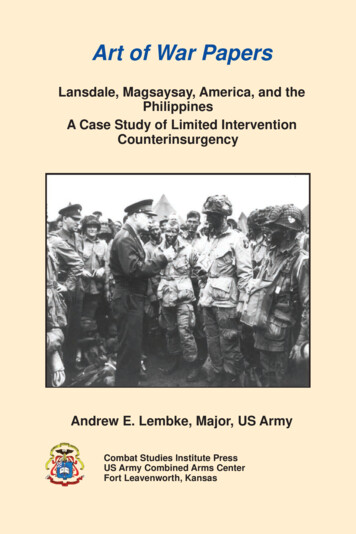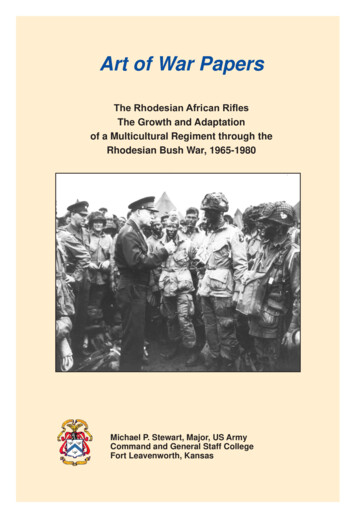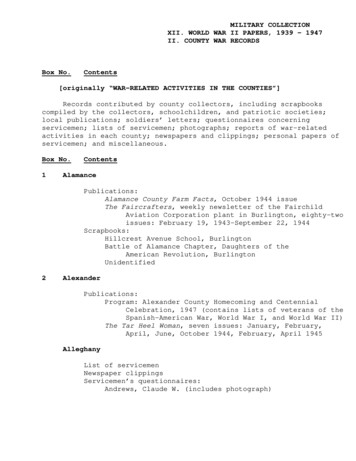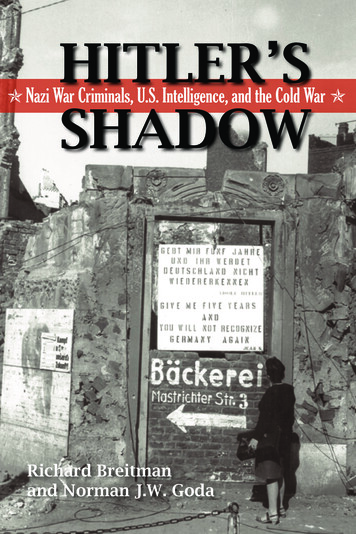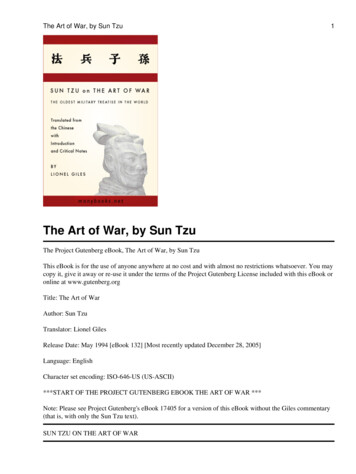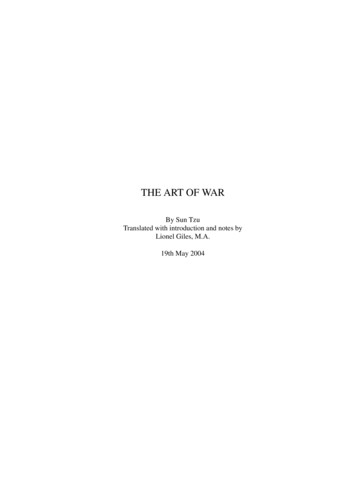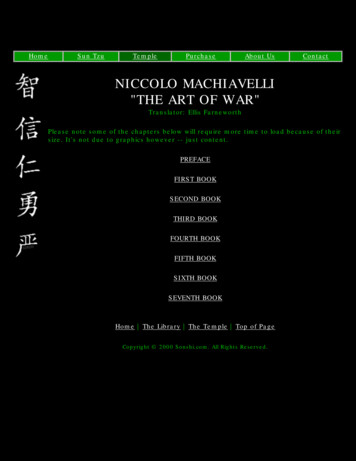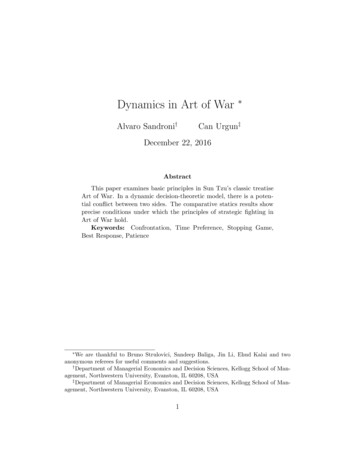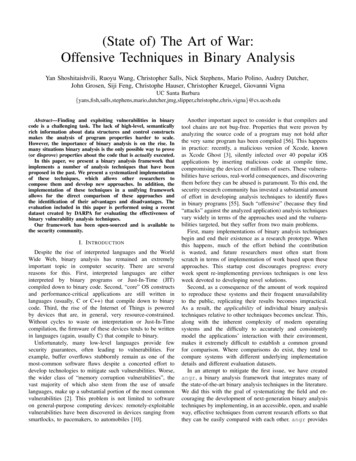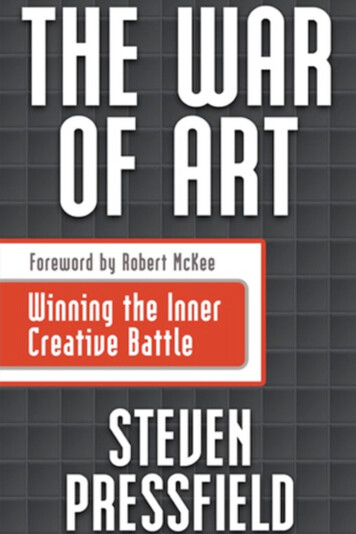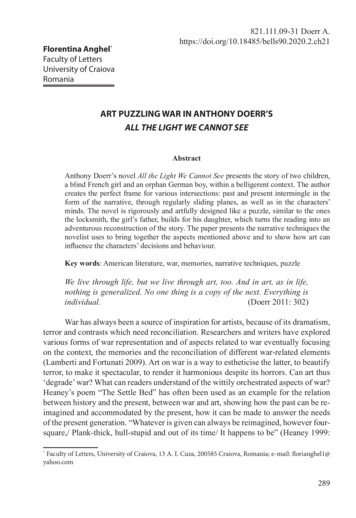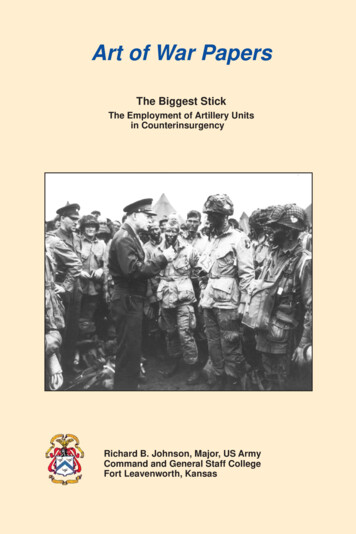
Transcription
Art of War PapersThe Biggest StickThe Employment of Artillery Unitsin CounterinsurgencyRichard B. Johnson, Major, US ArmyCommand and General Staff CollegeFort Leavenworth, Kansas
The cover photo courtesy of the Library of Congress is that of GeneralDwight Eisenhower giving orders to American paratroopers in England.
The Biggest Stick:The Employment of Artillery Unitsin CounterinsurgencyA thesis presented to the Faculty of the U.S. ArmyCommand and General Staff College in partialfulfillment of the requirements for thedegreeMASTER OF MILITARY ART AND SCIENCEArt of WarByRICHARD B. JOHNSON, MAJOR, UNITED STATES ARMYM.A., Webster University, Saint Louis, Missouri, 2006B.S., United States Military Academy, West Point, New York, 1999Fort Leavenworth, Kansas2011-01
Library of Congress Cataloging-in-Publication DataJohnson, Richard B.The biggest stick : the employment of artillery units in counterinsurgency /Richard B. Johnson.p. cm. -- (Art of war)“A thesis presented to the Faculty of the U.S. Army Command and GeneralStaff College in partial fulfillment of the requirements for the degree Master ofMilitary Art and Science.”Includes bibliographical references and index.ISBN 978-0-9837226-9-4 (alk. paper)1. Artillery--Case studies. 2. Counterinsurgency--Case studies. 3. Malaya-History--Malayan Emergency, 1948-1960--Artillery operations, British.4. Vietnam War, 1961-1975--Artillery operations, American. 5. Iraq War,2003-2011--Artillery operations, American. I. Title.UF400.J65 2012358.1’24--dc232012020261Combat Studies Institute Presspublications cover a wide varietyof military history topics. Theviews expressed in this CSI Presspublication are those of theauthor(s) and not necessarily thoseof the Department of the Army orthe Department of Defense. A fulllist of CSI Press publications, many of them available fordownloading, can be found at http://usacac.army.mil/CAC2/CSI/index.asp.The seal of the Combat Studies Institute authenticatesthis document as an official publication of the CSI. It isprohibited to use CSI’s official seal on any republicationwithout the express written permission of the Director ofCSI.ii
AbstractThe Biggest Stick:The Employment of Artillery Units inCounterinsurgencyBy Major Richard B. JohnsonThis study uses a comparative analysis of the Malayan Emergency,the American experience in Vietnam, and Operation IRAQI FREEDOM toexamine the role and effectiveness of artillery units in complex counterinsurgency environments. Through this analysis, four factors emerge whichimpact the employment of artillery units: the counterinsurgency effort’srequirement for indirect fires; constraints and limitations on indirect fires;the counterinsurgency effort’s force organization; and the conversion costof nonstandard roles for artillery units. In conclusion, the study offers fivebroadly descriptive fundamentals for employing artillery units in a counterinsurgency environment: invest in tactical leadership, exploit lessonslearned, support the operational approach and strategic framework, maintain a pragmatic fire support capability, and minimize collateral damage.Finally, the study examines the role of education for leaders in a counterinsurgency, and its influence on these imperative fundamentals.iii
Objectives of the Art of War Scholars ProgramThe Art of War Scholars Program is a laboratory for criticalthinking. It offers a select group of students a range of accelerated,academically rigorous graduate level courses that promoteanalysis, stimulate the desire for life-long learning, and reinforceacademic research skills. Art of War graduates will not besatisfied with facile arguments; they understand the complexitiesinherent in almost any endeavor and develop the tools andfortitude to confront such complexities, analyze challenges, andindependently seek nuanced solutions in the face of those whowould opt for cruder alternatives. Through the pursuit of theseoutcomes, the Art of War Scholars Program seeks to improve anddeepen professional military education.The Art of War Program places contemporary operations(such as those in Iraq and Afghanistan) in a historical frameworkby examining earlier military campaigns. Case studies andreadings have been selected to show the consistent level ofcomplexity posed by military campaigns throughout the modernera. Coursework emphasizes the importance of understandingprevious engagements in order to formulate policy and doctrinalresponse to current and future campaigns.One unintended consequence of military history educationis the phenomenon of commanders and policy makers “cherrypicking” history—that is, pointing to isolated examples frompast campaigns to bolster a particular position in a debate,without a comprehensive understanding of the context in whichsuch incidents occurred. This trend of oversimplification leavesmany historians wary of introducing these topics into broader,more general discussion. The Art of War program seeks to avoidthis pitfall by a thorough examination of context. As one formerstudent stated: “The insights gained have left me with morequestions than answers but have increased my ability to understandgreater complexities of war rather than the rhetorical narrative thataccompanies cursory study of any topic.”Professor Michael Howard, writing “The Useand Abuse of Military History” in 1961, proposed aframework for educating military officers in the art ofwar that remains unmatched in its clarity, simplicity,and totality. The Art of War program endeavors toiv
model his plan:Three general rules of study must therefore beborne in mind by the officer who studies militaryhistory as a guide to his profession and who wishesto avoid pitfalls. First, he must study in width. Hemust observe the way in which warfare has developedover a long historical period. Only by seeing whatdoes change can one deduce what does not; and asmuch as can be learnt from the great discontinuitiesof military history as from the apparent similarities ofthe techniques employed by the great captains throughthe ages .Next he must study in depth. He shouldtake a single campaign and explore it thoroughly,not simply from official histories, but from memoirs,letters, diaries. . . until the tidy outlines dissolve andhe catches a glimpse of the confusion and horror ofreal experience and, lastly, he must study in context.Campaigns and battles are not like games of chess orfootball matches, conducted in total detachment fromtheir environment according to strictly defined rules.Wars are not tactical exercises writ large. They are conflicts of societies, and they can be fully understoodonly if one understands the nature of the society fightingthem. The roots of victory and defeat often have tobe sought far from the battlefield, in political, social,and economic factors which explain why armies areconstituted as they are, and why their leaders conductthem in the way they do .It must not be forgotten that the true use of history,military or civil is not to make men clever for thenext time; it is to make them wise forever.Gordon B. Davis, Jr.Brigadier General, US ArmyDeputy Commanding GeneralCAC LD&EDaniel MarstonDPhil (Oxon) FRHistSIke Skelton Distinguished Chairin the Art of WarUS Army Command & GeneralStaff Collegev
AcknowledgmentsThe largest amount of gratitude possible goes to my ladies: Lea, Lucia,and Stella. Unfortunately you shared my attention with the large volumesof writing listed in the Bibliography. The last class told us at the beginning that “it is only a lot of reading if you do it.” With your grace, I did it.Without your support and love, this paper would not have been completed,much less started.To Aaron, Ben, Dustin, Mark, Nate, Rob, and Tom. Thanks for yourpatience as I tried to explain my incoherent themes while this project wasin its infancy. Appreciation is also in order for our brothers in arms in boththe British and American Armies, who extended us the best in hospitality,camaraderie, and discussion during our research trips.Thanks to the real experts who helped: Bruce Gudmundsson at Quantico for taking time out to discuss all things artillery, John Dubuisson inthe CARL for showing me how to get to “the goods” in military history archives, and especially Dr. Daniel Marston for making sense of it all whenI could not.Finally, to the Paratroopers of the 1st Battalion, 319th Airborne FieldArtillery Regiment and all of the attachments during the various iterations of Task Force Loyalty. Counterinsurgency is equal parts combatinginsurgents and combating a longing for home; I am in unwavering debtto you for the efforts with both. This work is dedicated to your sacrificesduring The Long War. I have looked through a good portion of history andI cannot find another artillery unit that embodies the character of adaptiveness, perseverance, and determination in counterinsurgency better thanthis group although I may be a bit biased.vi
ContentsAbstract. iiiAcknowledgments. viTable of Contents. viiGlossary. viiiChapter 1 Introduction. 1Chapter 2: The Themes of Counterinsurgency and Artillery Units. 7Chapter 3: The Malayan Emergency. 39Chapter 4: The American Experience in Vietnam. 65Chapter 5: Operation IRAQI FREEDOM.117Chapter 6: Conclusions. 187Bibliography. 197vii
GlossaryAABAdvise and Assist BrigadeAEIAmerican Enterprise InstituteACRArmored Cavalry RegimentAPCAccelerated Pacification ProgramAQIAl Qaeda in IraqARAAerial Rocket ArtilleryARVNArmy of the Republic of VietnamBCTBrigade Combat TeamCAPCombined Action PlatoonCDECollateral Damage EstimateCEACaptured Enemy AmmunitionCENTCOMCentral CommandCIACentral Intelligence AgencyCIDGCivilian Irregular Defense GroupCJTFCoalition / Joint Task ForceCORDSCivil Operations and Revolutionary DevelopmentSupportCOSVNCentral Office for South VietnamCPACoalition Provisional AuthorityCTCommunist TerroristCTZCorps Tactical ZoneDMZDe-Militarized ZoneDWECDistrict War Executive CouncilEFPExplosively Formed ProjectileFAField ArtilleryFOBForward Operating BaseFSBFire Support BaseGMLRSGuided Multiple Launch Rocket SystemGOCGeneral Officer CommandingGoIGovernment of IraqH&IHarassment and InterdictionHUMINTHuman IntelligenceIAIraqi ArmyIEDImprovised Explosive Deviceviii
INGIraqi National GuardISFIraqi Security Force(s)JAMJaysh al MehdiJCSJoint Chiefs of StaffJSSJoint Security StationMAAGMilitary Advisory and Assistance GroupMACVMilitary Assistance Command, VietnamMCPMalayan Communist PartyMiTTMilitary Training Team or Military Transition TeamMLRSMultiple Launch Rocket SystemMNC-IMulti-National Corps - IraqMND-BMulti-National Division - BaghdadMNF-IMulti-National Force - IraqMNSTC-IMulti-National Security Transition Command - IraqMPABAMalayan Peoples’ Anti-British ArmyMRLAMalayan Races Liberation ArmyNPNational PoliceNVANorth Vietnamese ArmyOCOOffice of Civil OperationsOIFOperation Iraqi FreedomONDOperation New DawnORHAOffice for Reconstruction and HumanitarianAssistancePFPopular ForcesPGMPrecision Guided MunitionPRTProvincial Reconstruction TeamRARoyal ArtilleryRFRegional ForcesROERules of EngagementRPGRocket-Propelled GrenadeSASSpecial Air ServiceSEPSurrendered Enemy PersonnelSOISons of IraqSVNSouth VietnamSWECState War Executive Councilix
USAIDUnited States Agency for InternationalDevelopmentUSMCUnited States Marine CorpsVBIEDVehicle Borne Improvised Explosive DeviceVCVietcongWMDWeapon(s) of Mass DestructionARTILLERY UNIT: A brigade-, battalion-, or battery-level force capableof providing lethal indirect fires by means of integrated fire support taskedto maneuver units; a fire direction element; and assigned guns, howitzers, orlaunchers to deliver lethal fires.COUNTERINSURGENCY: The actions taken by a government to limit ordefeat an insurgency.FIRE SUPPORT: The fires that support land, maritime, amphibious, andspecial operations forces to engage enemy forces, combat formations, andfacilities in pursuit of tactical and operational objectives.FIRES: The effects of lethal or nonlethal weapons.INDIRECT FIRES: Fire delivered on a target that is not itself used as a pointof aim for the weapon or the director.INSURGENCY: An organized movement aimed at the overthrow of aconstituted government through the use of subversion and armed conflict.OPERATIONAL APPROACH: The use of operational art in a specificenvironmental context; the pursuit of a strategic objective by arranging tacticalactions in time, space, and purpose.x
Chapter 1IntroductionModern wars are not internecine wars in which the killing of the enemy is the object. The destruction of the enemyin modern war, and, indeed modern war itself, are means toobtain that object of the belligerent which lies beyond the war.― Deputy Chief of Staff for Military Operations, Program for the Pacification and Long-Term Development ofSouth VietnamI have noticed that the mere mention of the word “pacification” to a group of soldiers, whatever their rank, usuallybrings forth deriding smiles. Many of them seem to think ofpacification as the distribution of candies to the children andsmiles to the old people. We certainly must show the carrotin our left hand, but only if we brandish a stick in our righthand. If skepticism about pacification is prevalent today,it is due to the fact
The Art of War program seeks to avoid this pitfall by a thorough examination of context. As one former student stated: “The insights gained have left me with more questions than answers but have increased my ability to understand greater complexities of war rather than the rhetorical narrative that accompanies cursory study of any topic.” Professor Michael Howard, writing “The Use and .
